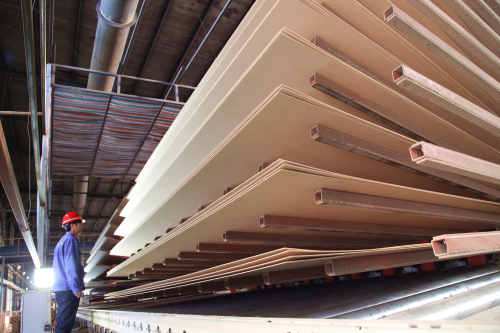|
 |
|
GREEN MOVE: A production line operator examines high-density fiberboards made of leftover materials in the timber logging industry in Chengde, Hebei Province, on December 1 (XINHUA) |
PMI Results
Growth in China's manufacturing sector remained moderate in November, according to data released by the National Bureau of Statistics (NBS) and the China Federation of Logistics and Purchasing (CFLP) on December 1.
The official manufacturing purchasing manager's index (PMI) slipped to 50.3 in November from 50.8 in October but remained above the 50-point mark that separates growth from contraction on a monthly basis.
Although the November PMI fell slightly, it remained above the boom-bust line, suggesting the manufacturing sector was generally expanding, NBS analyst Zhao Qinghe said.
The breakdown of the official PMI showed that downward pressure on domestic demand was increasing while external demand was decelerating, said Bob Liu, analyst at the China International Capital Corp.
According to Liu, temporary factory shutdowns imposed in Beijing and neighboring regions in early November to ensure cleaner air during the Asia-Pacific Economic Cooperation Leaders' Meeting may have helped to aggravate the slowdown in that month.
Among the sub-indices, the production index posted at 52.5, down from October's 53.1. The index of new orders slipped from October's 51.6 to 50.9 while that of new export orders fell to 48.4 in November from 49.9 in the previous month. The employment sub-index declined from 48.4 in October to 48.2.
On the other side of the equation, China's service sector activity slightly recovered in November. The PMI for the non-manufacturing sector rebounded to 53.9 in November from 53.8 in October, according to the NBS and the CFLP.
Tax Scrutiny
China will establish a comprehensive system to monitor foreign companies' profitability in order to curb cross-border tax evasion, the State Administration of Taxation (SAT) announced on December 1.
The move is one of several steps against tax avoidance taken by the agency to protect the country's interests as the world's top destination for foreign direct investment.
The system will allow the agency to acquire profit information on foreign companies so that it can launch "targeted actions" and use information technology to prevent companies from shifting profits overseas, said Zhang Zhiyong, Deputy Director of the SAT.
The ongoing campaign against corporate tax dodging has rippled through the foreign business community in China, following the government's move to levy $140 million in back taxes on U.S.-based Microsoft Corp. Microsoft has denied that it practiced tax avoidance.
Data Link
On December 3, China's Huawei Technologies Co. Ltd., a global leader company in information and communications technology (ICT), and Belgium-based nanoelectronics research center Imec announced their strategic partnership on optical data link technology.
Their joint research on silicon-based optical interconnection is expected to deliver benefits including high speed, low power consumption and cost savings.
"This is an important next step in our collaboration with Huawei on silicon photonics. This collaboration shows that our silicon photonics research is important for advancing next-generation high-bandwidth ICT solutions," Imec President and CEO Luc Van den Hove said.
Silicon photonics is a key technology expected to revolutionize optical communications by enabling the creation of highly integrated, low-power optical transceivers used for data transmission and telecommunications.
In 2013, Huawei acquired photonics company Caliopa, jointly created by Imec and Ghent University, thereby adding silicon photonics research to its European research and development (R&D) portfolio.
"Having acquired cutting-edge expertise in the field of silicon photonics thanks to our acquisition of Caliopa last year, this partnership with Imec is the logical next move toward next-generation optical communication," CEO of Huawei Belgium Hudson Liu said.
Huawei's products and solutions are available in more than 170 countries, serving more than one third of the world's population. The company currently has a staff of more than 7,700 people in Europe, 850 of whom are working in R&D.
| 